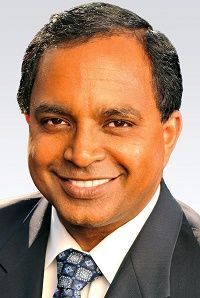Article
Spine Surgeon Touches a Nerve with Text Neck Study
Author(s):
A spine surgeon's study became international news when he found smartphone usage can negatively impact the spine. But the physician sees opportunity in the results.

Imagine walking along the street, smart phone in hand, head bent forward as you read off an assortment of text messages and decide which needs your immediate response.
That’s probably not too difficult to imagine, since you and millions of individuals like you engage in that activity every day, whether it’s with a smart phone, iPad, or other mobile device. But do you know what you’re doing to your neck and spine in the process?
According to a recent study by Kenneth Hansraj, MD, chief of spine surgery at New York Spine Surgery & Rehabilitation Medicine, the weight on the spine dramatically increases when flexing the head forward at varying degrees.
“That’s like walking around with an 8-year old on your shoulders for a couple of hours a day,” Hansraj says.
Room for Development
Hansraj opted for a career in medicine because ever since he was a young boy his father wanted him to become a surgeon.
“I loved my dad a lot,” Hansraj recalls. “I didn’t think it would be possible, but I tried.”
And he succeeded. He chose orthopedic surgery over other fields of medicine because of the developmental work still being done.
“Spine is complicated,” he explains. “It takes many years to develop some mastery. And I love the fact that it’s intricate. It’s complicated.”
Hansraj compared the spine to Grand Central Station in the way it sends out communication signals to all parts of the body. He’s been practicing for 20 years, has seen about 30,000 patients, and performed at least 3,000 surgeries. That experience prompted his book, “Keys to an Amazing Life: Secrets of the Cervical Spine” (Dee Dee LLC, 2012).
“It began to occur to me that there are strategies regular people can take to live better lives and enjoy a better manifestation of their spines,” he says. “These are very simple strategies, and people can use them to live a better life than if they have surgery.”
Incremental Discovery
It was around that time that Hansraj encountered a male patient around 32-years old. The young man had a herniated disk accompanied by back and neck pain. For months Hansraj tried every strategy he could think of—physical therapy, injections, and various conservative approaches, but the young man was not getting better.
“We were both very frustrated,” Hansraj recalls.
Then one day while chatting, the young man revealed that he would spend about 4 hours a day, head down, playing computer games on his iPad. The light bulb went on as Hansraj made the connection between poor posture and spine surgery. That connection led to the study mentioned earlier; a study that Hansraj estimates will approach 4 billion in readership.
“We were amazed,” says Hansraj of the number of people who have read the study. “I think what happened is we put out a study, and it really touched a nerve of the world. Everybody has a cell phone, and everybody’s involved.”
According to the study, an adult head weighs between 10 and 12 pounds in a neutral, straight-up position. As a person tilts his or her head forward, “…the forces seen by the neck surges to 27 pounds at 15 degrees, 40 pounds at 30 degrees, 49 pounds at 45 degrees, and 60 pounds at 60 degrees.”
Positive Message
The results of study were, of course, quite alarming, and began spreading like wild fire. Results appeared via many major US media outlets, including Time Magazine, The Today Show, Fox News, CBS, ABC, NPR, and The New York Times. International publications also caught on, creating a surge of readership in the Middle East as well as China.
Once the media latched on to the study and its implications, the term text neck appeared, and there are now websites cautioning against “a global epidemic” and a “world-wide health concern.” Hansraj, however, says his message is much more positive.
“Our message is not bashing cell phones,” he says. “If you keep your head up, if you lift your cell phone up a bit, you’ll have a better outcome in terms of the stress being experienced by your neck. It’s very simple, and very smart. Just keep your head up.”
The study acknowledges that “it is nearly impossible to avoid the technologies that cause these issues,” but echoes Hansraj’s advice to use these devices with a neutral spine. In other words, “…avoid spending hours each day hunched over.”
Coming to a Realization
When he’s not lighting up the world with spine study results, Hansraj enjoys long walks in the woods, running, and skiing. He combines the latter with his love for spending time with his wife and son with a “big vacation” each year to ski. Spending time together, he says, is his reward.
But on the medical front, his reward is a realization.
“It’s one thing for a human being to be in jail and absolutely incarcerated,” Hansraj says. “It’s another when the spinal cord and nerve roots are incarcerated by disease or destruction of the spine.”
In those situations he finds it extremely rewarding to take a patient through surgery and alleviate their discomfort.
“That is absolutely the most gratifying feeling in the world.”




